
John William Waterhouse
Boreas (detail), 1903
(Private Collection) Primrose Hill Studios
.“If the sign at the entrance hadn’t proclaimed PRIMROSE HILL STUDIOS in grand lettering, I’d have thought we’d stumbled into a fairy tale. Primrose Hill Studios, where St. John Dulac and his wife made his residence, was located near the lush green hills of Regent Park some miles north of our home in Brompton. The studio complex was set off a busy road down a cobblestoned path framed by grey-stoned walls. This path led to a small grass-covered courtyard around which about a dozen red brick townhouses were co-joined like sisters holding hands. Each house bore identical cobalt-painted wood doors and mullioned windows.”

John William Waterhouse occupied a studio at Primrose Hill Studios, a purpose built artists' community in north London, from 1878 until 1900. His fellow artists included William Logsdail (one of his closest friends), Maurice Greiffenhagen, and George Denholm Armour (1864-1949). ( G.D. Armour later wrote about his memories of the community in Bridle and Brush, published in 1937) whose painting of the Lady of Shalott inspired THE LILY MAID."There were twelve studios round a court, some of which were occupied by people of note.
J.W. Waterhouse, R.A., was one, Maurice Greiffenhagen another, and others of us of less importance. It was a very happy little colony, and we had great fun outside our work.
Waterhouse's studio was a never-failing place of meeting, and he and his wife the best of hosts. Greiffenhagen was, when in the humour, a wonderful pianist. He played the piano by instinct--there is no other word for it. I have gone with him to some kind of light opera and seen him, on our return, though almost unable to read music, sit down and give a vivid impression of what we had heard, orchestration and all.
...
He was fond of fun, and,
like dear old quiet Waterhouse, took his part in all the nonsense we amused ourselves with at Primrose Hill. I remember some
tableaux vivants in which we caricatured each other's pictures. Mine, being mostly of animals, were exempt, but I personally did not escape so easily, as, being the only clean-shaven member of the party, I was cast for all the female parts involved. This, to any one who knows my physical characteristics, was joke number one, and a good one. One of the pictures caricatured was Greiffenhagen's well-known "Idyll," now in the Liverpool Art Gallery. As all the world knows it represents a shepherd embracing a very pretty shepherdess among large, red poppies. A Scotsman, Torrance by name, did the part of the shepherd, I was the "pretty" shepherdess! The poppies were constructed from scarlet tissue paper, something like a sheet for each, so they certainly could not be overlooked.
Another tableau was Waterhouse's picture of Circe, and here again I filled the title role: the result may be imagined! A few outside friends were admitted to these entertainments, among them a son of Charles Dickens, but there were also many purely studio evenings which, though hardly worth record, were amusing to those who took part. Boxing-gloves and foils were requisitioned at times, and though none of us was even reasonably proficient with either, our very ineptitude was a delight to the onlookers.
One of our occasional visitors was Fred Norton, later to become well known as the composer of the music for
Chu Chin Chow and other successful things; besides being a first-class musician he was very amusing company."
As you can see from my photographs, it’s a serene secret of a place. whilst looking through John William Waterhouse’s old sketchbooks at the V&A, I discovered the names of several models,
whilst looking through John William Waterhouse’s old sketchbooks at the V&A, I discovered the names of several models, recorded by the artist along with details of their addresses. In one of the sketchbooks (E.1111-1963) two names particularly caught my attention as they were inscribed, as an aide-mémoire for the artist,
recorded by the artist along with details of their addresses. In one of the sketchbooks (E.1111-1963) two names particularly caught my attention as they were inscribed, as an aide-mémoire for the artist,  "Lachrymae," the title chosen by the artist, is the Latin word for "tears." Every aspect of the composition emphasizes the subject, from the fading sunset to the cypress trees (traditional symbols of death, because once cut, they do not regenerate) and laurel bushes (like cypress, laurel is evergreen and, thus, a symbol of immortality). The overall Hellenic theme of the canvas reflects contemporary Victorian interest in Greek funerary art.model mary lyold
"Lachrymae," the title chosen by the artist, is the Latin word for "tears." Every aspect of the composition emphasizes the subject, from the fading sunset to the cypress trees (traditional symbols of death, because once cut, they do not regenerate) and laurel bushes (like cypress, laurel is evergreen and, thus, a symbol of immortality). The overall Hellenic theme of the canvas reflects contemporary Victorian interest in Greek funerary art.model mary lyold
Leighton was already suffering from what would prove to be fatal heart disease when he painted this melancholy work. He was at the height of his fame, having served as president of the Royal Academy for more than fifteen years. As he did with several of his other pictures, Leighton selected the frame; in this case, one that creates the impression of viewing the scene through a doorway.beside a sketch of Echo and Narcissus. The names ‘Beresford’ and what I initially deciphered as “Miss Bantick’ clearly related to the models who posed for Waterhouse’s celebrated painting, exhibited at the Royal Academy in 1903, and now in the Walker Art Gallery, Liverpool.Peter Trippi describes the women in Waterhouse's works as an "idealized, instantly recognizable type."It proved an easy task to identify the former – ‘Beresford’, along with his address at 19 St Olaf’s Road, Fulham, matched up with an entry for a ‘Henry Beresford’ in the 1901 Census. The 21 year old was living there with his 42 year old widowed mother, Clara, and gives his occupation as ‘Artist’s Model’ in the census entry. Fulham may initially seem an unlikely place to find the model for Narcissus, but the area had been home to artists like Burne-Jones and Holman Hunt, and a number of Italian models had settled in the neighbouring borough of Hammersmith.
matched up with an entry for a ‘Henry Beresford’ in the 1901 Census. The 21 year old was living there with his 42 year old widowed mother, Clara, and gives his occupation as ‘Artist’s Model’ in the census entry. Fulham may initially seem an unlikely place to find the model for Narcissus, but the area had been home to artists like Burne-Jones and Holman Hunt, and a number of Italian models had settled in the neighbouring borough of Hammersmith. ~"... Waterhouse transcended the particularities of individual models to present his own
~"... Waterhouse transcended the particularities of individual models to present his own
idealized, instantly recognizable type ... Older contemporaries, such as Rossetti ,
,
Poynter and Moore, had devised their own types." (Peter Trippi, J.W. Waterhouse, 2002)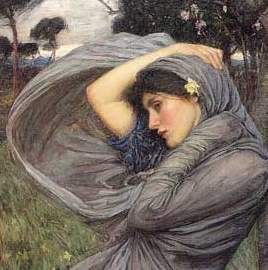
In his 2003 monograph on Herbert Draper, Simon Toll recorded that Harry Beresford had modelled for John William Waterhouse’s Echo and Narcissus, but also that, aged 14, he had posed for Draper’s the Youth of Ulysses, although in the finished version of that painting the artist worked from Giuseppi Servi, a young ice cream vendor from
had modelled for John William Waterhouse’s Echo and Narcissus, but also that, aged 14, he had posed for Draper’s the Youth of Ulysses, although in the finished version of that painting the artist worked from Giuseppi Servi, a young ice cream vendor from  Hammersmith. The final model for the head of ‘Athene’ in Draper’s painting was Mary Lloyd, who is also known to have posed for Waterhouse, amongst others. It is also known that Waterhouse introduced Draper to another of his models, Agnes Richardson, although Draper thought her sister Edith the better model.In June 2006 an old vellum bound book appeared on the art market, which had been used by the artist John Seymour Lucas RA (1849-1923) to record the addresses of clients and models. The artist had made notes on the sitters’ facial features, complexion, hair colour etc and in many cases included a thumbnail sketch of the model’s face.
Hammersmith. The final model for the head of ‘Athene’ in Draper’s painting was Mary Lloyd, who is also known to have posed for Waterhouse, amongst others. It is also known that Waterhouse introduced Draper to another of his models, Agnes Richardson, although Draper thought her sister Edith the better model.In June 2006 an old vellum bound book appeared on the art market, which had been used by the artist John Seymour Lucas RA (1849-1923) to record the addresses of clients and models. The artist had made notes on the sitters’ facial features, complexion, hair colour etc and in many cases included a thumbnail sketch of the model’s face. Ronald Graham had also written about the Waterhouse "type" in 1904.
Ronald Graham had also written about the Waterhouse "type" in 1904.
"... such painters as Mr JW Waterhouse, R.A. also keep true to their own type of manhood
and
womanhood however much they may be influenced by the model of the moment."
(Ronald Graham "Models for Famous Pictures", The Strand Magazine, September, 1904 - Courtesy Julia Kerr)
In a short video from RTV Noord, a Dutch news organization, Peter Trippi briefly talked about some of the paintings that were on exhibit as part of the Waterhouse Retrospective presented at the Groninger Museum from December 2008 through 3 May 2009.
He also described the "Waterhouse girl" - or Waterhouse's "ideal type" - as an "an invented beauty".
Peter goes on to say, "... it seems to me Waterhouse's ideal type was very much about what we call an English rose style." (Video link.)The names were entered in the book alphabetically, and at the top of one page in the ‘B’ section appears ‘Harry Beresford...aged 16, 1896,’ along with his Fulham address. As well as recording that he had ‘dark hair’, Seymour Lucas also describes him as ‘a very good looking young model - sits to Roe, who recommends him strongly’. The likeness of Harry Beresford accords almost exactly with one of the figures in Seymour Lucas’s 1896 Royal Academy picture A Story of the Spanish Main. 
John Seymour Lucas
A Story of the Spanish Main, 1896
from Royal Academy Pictures, 1896 |
The facial resemblance to Narcissus is less obvious, but thanks to the annotations in the Seymour Lucas address book we can confirm that this depicts young Harry’s appearance at the time. Further down the page in the address book the artist has sketched a second sitter, this time a female model. Although, once again, Seymour Lucas’s likeness of her bears no marked resemblance to the model for Echo, the name ‘Miss Bantock’ is more clearly inscribed than in Waterhouse’s hand in his own sketchbook. She appears on the same page of the address book as Harry Beresford because her surname also begins with ‘B’, but both models were probably introduced to Seymour Lucas at around the same time. With the correct spelling of her name I had no trouble finding ‘Ethel Bantock’ in the 1901 Census – listed as a 25 year old artist’s model living in Hammersmith. Seymour Lucas records two addresses for Miss Bantock, the second at
I had no trouble finding ‘Ethel Bantock’ in the 1901 Census – listed as a 25 year old artist’s model living in Hammersmith. Seymour Lucas records two addresses for Miss Bantock, the second at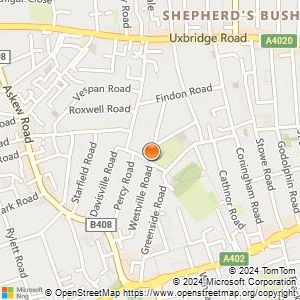 ‘Cambridge House, Westville Road, Shepherd’s Bush’ matching the one recorded for the same sitter in Waterhouse’s sketchbook. Seymour Lucas notes that she is ‘age 21’ of ‘fair hair & complexion’ and, like Beresford, ‘sat to Roe a good deal’.
‘Cambridge House, Westville Road, Shepherd’s Bush’ matching the one recorded for the same sitter in Waterhouse’s sketchbook. Seymour Lucas notes that she is ‘age 21’ of ‘fair hair & complexion’ and, like Beresford, ‘sat to Roe a good deal’. Whilst Seymour Lucas was a very successful painter of history genre artworks, his pupil, Frederic Roe (1864-1947), proved to be a very competent follower of his style, and just as successful. It would appear, then, that the younger artist had spotted the Bantock and Beresford double-act first, and then introduced them to Seymour Lucas several years before they were to sit to Waterhouse in the roles of Echo and Narcissus. It has proved more difficult spotting Ethel Bantock amongst Seymour Lucas’s many canvases, although I had at least some success in finding her in one of Fred Roe’s paintings. Throughout the 1890s he often treated the subject of Joan of Arc, but it is his 1906 Royal Academy picture Martyrdom: Joan of Arc on her way to Execution that most obviously features the elusive Ethel. For the figure of St Joan, the artist has chosen a model with a strong jaw, fair skin and a left foot that looks identical to Echo’s. She appears again in a Study for Joan the Martyr painted by Roe in 1905.
Whilst Seymour Lucas was a very successful painter of history genre artworks, his pupil, Frederic Roe (1864-1947), proved to be a very competent follower of his style, and just as successful. It would appear, then, that the younger artist had spotted the Bantock and Beresford double-act first, and then introduced them to Seymour Lucas several years before they were to sit to Waterhouse in the roles of Echo and Narcissus. It has proved more difficult spotting Ethel Bantock amongst Seymour Lucas’s many canvases, although I had at least some success in finding her in one of Fred Roe’s paintings. Throughout the 1890s he often treated the subject of Joan of Arc, but it is his 1906 Royal Academy picture Martyrdom: Joan of Arc on her way to Execution that most obviously features the elusive Ethel. For the figure of St Joan, the artist has chosen a model with a strong jaw, fair skin and a left foot that looks identical to Echo’s. She appears again in a Study for Joan the Martyr painted by Roe in 1905. 
Frederic Roe
Martyrdom: Joan of Arc on her way to Execution, 1906
from Royal Academy Pictures, 1906

Frederic Roe
Study for Joan the Martyr, 1905
Private Collection, London |
Whilst some of the models employed by Waterhouse clearly sat to him on a regular basis, the names and addresses recorded alongside the sketch of Echo and Narcissus suggests that Bantock and Beresford only first made his acquaintance around 1902-03. Several studies for the painting are known – including further preliminary sketches in the aforementioned V&A sketchbook, as well as more worked up individual studies for the head and figure of Echo. Whether either model sat to Waterhouse again remains open to conjecture – their services were clearly in demand from other artists, however more than an echo of both their likenesses appear in his 1905 painting of Lamia. At around the time of these discoveries, a hitherto unrecorded charcoal study by Waterhouse for Echo appeared on the art market with a price tag of more than fifty times that of what the original painting sold for in 1903. It is not clear if this version was drawn from Ethel or from another model, as the face differs somewhat from the one which appears in the finished oil. 
John William Waterhouse,
Study for the head of Echo, c1903
(Christies 9 Feb 1990, no 254) | 
John William Waterhouse,
Study, c1903
(The Studio, 1908 vol.44, p255) |

John William Waterhouse,
Lamia, 1905
(Private Collection) | 
John William Waterhouse,
Study for Echo
from Echo and Narcissus, c1903
(Private Collection) |
Today John William Waterhouse’s pictures are more popular than ever, and the fascination for his art extends to the lives of the artist, his friends and his models. Over a hundred years after its first exhibition, we are only just beginning to find out more about the models who posed for Echo and Narcissus. Were it not for a pencil note in one of Waterhouse’s sketchbooks, they might have remained unidentified forever.
The Mysterious Models John William Waterhouse was a classical, romanticist painter, giving to his art highly imaginative interpretations of mythological characters and personages from ancient history as well as from poetry and literature. Though that "idealized, instantly recognizable type" found in his paintings is part of what we remember and admire about the artist's work ... there is always interest in Waterhouse's models. Those who have sought to study the life of John William Waterhouse have sadly not found journals or other sources of information to guide them in their quest to learn more about this very private man. Information about the names of models other than family members has only started to come to light in recent years.
We have known that family members
posed for Waterhouse and appear in some of his works.
Jessie Waterhouse
The artist's sister
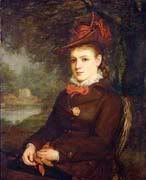
 John William Waterhouse
John William Waterhouse
Portrait of a Young Woman, 1875
Whispered Words, 1875There are no surviving photographs of Waterhouse's sister. Peter Trippi believes, though, that the above portrait by the artist could possibly be of Jessie. The catalogue entry for the painting, Whispered Words, included a poem about a woman named 'Jessie' and it is believed this refers to the artist's sister. If this painting and Portrait of a Young Woman are of Waterhouse's sister, it is thought her likeness also appears in other paintings by the artist through about 1880.
 John William Waterhouse
John William Waterhouse
Portrait of a Young Woman (detail), 1875
(Private Collection)Mary Waterhouse
---
The artist's half-sister
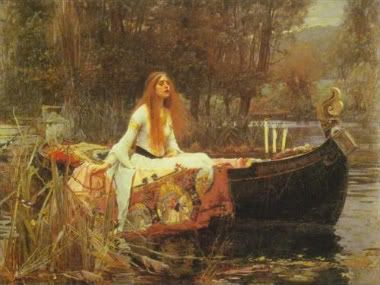 John William Waterhouse
John William Waterhouse
The Lady of Shalott, 1888
(Tate Britain, London, England) Dr John Physick, great-nephew of Waterhouse, shared in 2002: "... My father's mother was the artist's sister Mary. Nearly seventy years ago, she told me that her brother used her portrait as the model for The Lady of Shalott in the Tate Gallery." In his 2002 publication, Peter Trippi wrote that the model for The Magic Circle was probably "May Waterhouse."
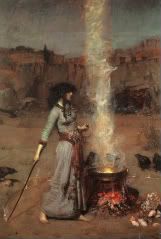 John William Waterhouse
John William Waterhouse
The Magic Circle, 1886
(Tate Britain, London, England) Esther Waterhouse
The artist's wife
"On September 8, 1883, John William Waterhouse married Esther Kenworthy at the parish church of St Mary, Ealing.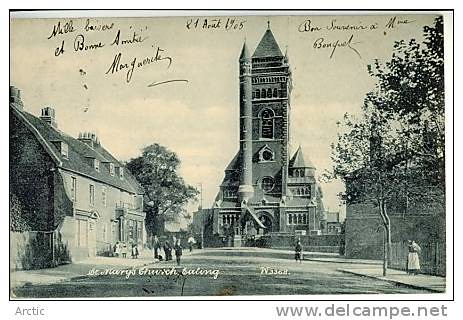 He was then thirty-four and she twenty-five. The names of his father, his step-mother, his sister Jessie, the bride’s mother and one of her brothers appear on the marriage certificate. Esther’s father, James Lees Kenworthy – himself an artist, who with his wife kept a school in Ealing – had died seven years previously.” (Anthony Hobson, The Art and Life of J.W. Waterhouse, RA, 1849-1917, 1980)
He was then thirty-four and she twenty-five. The names of his father, his step-mother, his sister Jessie, the bride’s mother and one of her brothers appear on the marriage certificate. Esther’s father, James Lees Kenworthy – himself an artist, who with his wife kept a school in Ealing – had died seven years previously.” (Anthony Hobson, The Art and Life of J.W. Waterhouse, RA, 1849-1917, 1980) 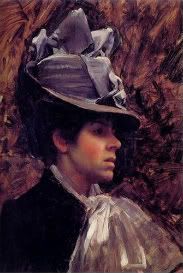 John William Waterhouse
John William Waterhouse
Esther Kenworthy Waterhouse (circa 1885)
(Sheffield City Art Galleries, Sheffield, England)And from Peter Trippi:
“… No records reveal when Nino and Esther met. Kenworthy family tradition suggests that they met through her father …”
“Esther’s career remains a mystery. Of the nine Kenworthy children, only she identified herself as an artist in the census … Esther did not study at the Slade or South Kensington, though perhaps elsewhere. She specialized in flower painting, and her documented career began in 1881 at the Academy, where she showed one or two pictures regularly until 1889, and where she may have met Nino. During the 1880s, Esther showed six pictures at the Royal Institute of Painters in Water Colours, and a handful at the SBA, New Gallery, Birmingham, Manchester and Liverpool.”
“Her exhibiting ended suddenly in 1890, for no obvious reason. … Esther’s art has vanished, was never reviewed, and there is no evidence that she collaborated with her husband on his paintings.” (Peter Trippi, J. W. Waterhouse, 2002)
One of the paintings Esther exhibited at the Royal Institute of Painters in Water Colours is included in the Institute's 1884 catalogue. Another record of her work is found in The Royal Academy of Arts: A Complete Dictionary of Contributors and Their Work from Its Foundation in 1769 to 1904 by Algernon Graves - she is listed in Vol. IV as Miss Esther Kenworthy and then in Vol. VIII as Mrs. John William Waterhouse. Her husband's name appears just before hers in Vol. VIII with the list of paintings he exhibited at the Royal Academy through 1904.
Another record of her work is found in The Royal Academy of Arts: A Complete Dictionary of Contributors and Their Work from Its Foundation in 1769 to 1904 by Algernon Graves - she is listed in Vol. IV as Miss Esther Kenworthy and then in Vol. VIII as Mrs. John William Waterhouse. Her husband's name appears just before hers in Vol. VIII with the list of paintings he exhibited at the Royal Academy through 1904. Nino (as Waterhouse was known to family and friends) and Esther Waterhouse can be found in The Bank and Royal Exchange, a painting by their friend and Primrose Hill Studios neighbor, William Logsdail. Waterhouse is seated to the left below, Esther sits beside him. Esther's brother-in-law, landscape painter Peregrine Feeney, and Esther's sister Emily are next. Logsdail sits behind the Waterhouses. Joseph Wolf sits behind and to the right of the Feeney's. 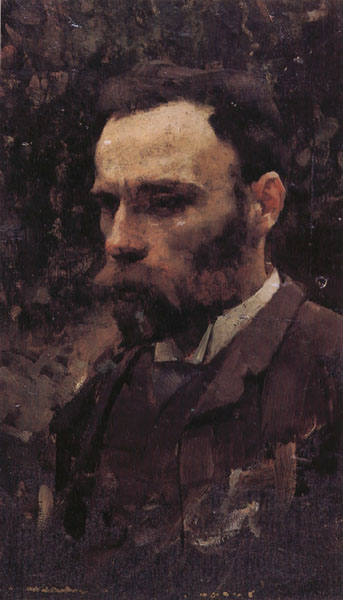 William Logsdail
William Logsdail
The Bank and Royal Exchange (detail), 1887
(Private Collection) The third photograph on the linked page that follows shows the Waterhouses with family and friends in the courtyard of the Primrose Hill Studios. Esther appears with other Primrose Hill artists in a cariature of 'The Primrose Hill SchoolArticles about J.W. Waterhouse
Caricature of The Primrose Hill School
In 1895 Waterhouse "showed a portrait of Phyllis, [Ernest Waterlow's] younger daughter. A talented landscapist, Waterlow served as president of the Royal Watercolour Society from 1897 to 1913; he and members of his family sat for various friends, including  Alma-Tadema and Hacker. Waterlow shared the Waterhouses' studios in 1892-3 during the renovation of his house, an experience commemorated by an unattributed caricature inscribed 'January 1893, Primrose Hill School'.
Alma-Tadema and Hacker. Waterlow shared the Waterhouses' studios in 1892-3 during the renovation of his house, an experience commemorated by an unattributed caricature inscribed 'January 1893, Primrose Hill School'.
Waterlow appears in profile at the top, and Waterhouse at centre facing the viewer; in keeping with the title, they and their friends are dressed like children. These artists are sketching a primate; through his career, Waterhouse drew an eagle, falcon, chimpanzees and pigs, yet his beloved doves are surprisingly absent from his sketchbooks. He probably derived at least some expertise in depicting animals from his neighbour Joseph Wolf, who appears in this caricature, and in painting flowers from Esther, whose back is to the viewer." The cariature was included in Peter Trippi's biography of Waterhouse. Trippi wrote that Waterhouse, "... probably derived at least some expertise in depicting animals from his neighbour Joseph Wolf, who appears in this caricature, and in painting flowers from Esther ...." It seems that Esther was also a writer. She is reported to have written reviews of theatre productions.
Between about 1892 and 1911, Nino and Esther Waterhouse spent some holidays at Croyde in Devon. Peregrine and Emily Feeney, had a home there (Hobson, Art, 51, 134). Julia Kerr shared with me that the name of the Feeney's home at Croyde was 'Spring Haven'. In response to an inquiry I made about 'Spring Haven', Deborah Gahan, Barnstaple Local Studies Librarian, shared the following information about Peregrine Feeney and the Baggy Point area near Croyde: "I have found P M Feeney listed as a private resident at 'Spring Haven' in Kelly's 1889 'Directory of Devon' and again in White's 1890 'History, Gazetteer & Directory of Devon' where the address is expanded to 'Spring Haven, Croyde Bay'. The 1891 Census shows a nephew, Harry Feeney Hyde in residence at 'Spring Haven' whilst Peregrine Feeney is recorded at 7 Primrose Hill Studios, St Pancras. In 1901 he is back in Croyde himself although the address is given as Baggy Point. The Census was recorded in order geographically and as this address appears in the same place in both years in relation to others I would think that the name of the property was either omitted or had been changed at this time.
In 1901 he is back in Croyde himself although the address is given as Baggy Point. The Census was recorded in order geographically and as this address appears in the same place in both years in relation to others I would think that the name of the property was either omitted or had been changed at this time.  Baggy Point is the headland of Croyde Bay
Baggy Point is the headland of Croyde Bay and there is a property known as 'Baggy House' ... If my memory serves me well the original house was demolished and replaced by a new building [2nd photo] of award winning design in recent years ... Looking at large scale OS mapping 'Baggy House' does not appear on the 1st Edition 25" c.1889 but does on the 2nd Edition c.1904. However there are other unnamed properties, one of which is further along the point and near a spring to which the name could have applied but this doesn't appear to be on the modern map."
and there is a property known as 'Baggy House' ... If my memory serves me well the original house was demolished and replaced by a new building [2nd photo] of award winning design in recent years ... Looking at large scale OS mapping 'Baggy House' does not appear on the 1st Edition 25" c.1889 but does on the 2nd Edition c.1904. However there are other unnamed properties, one of which is further along the point and near a spring to which the name could have applied but this doesn't appear to be on the modern map." It is thought Esther appears in the painting, Gathering Summer Flowers in a Devonshire Garden.
Peter Trippi notes, "In Gathering Flowers JWW wrote 'Croyde' below his signature."
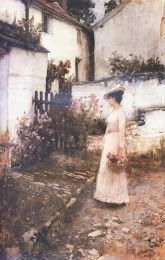 John William Waterhouse
John William Waterhouse
Gathering Summer Flowers in a Devonshire Garden (circa 1893-1910)
(Private Collection)Gwendoline Gunn
A friend of the family
The Marcus and Mary Eliza Gunn family also spent holidays at Croyde (Trippi, 207) and a friendship developed between the families - a friendship that would extend over several years. Gwendoline Gunn (1882-1977) was one of the Gunn's daughters. Mrs. Donner, Gwendoline's daughter, would later be one of the friends who helped care for Esther Waterhouse during her last days (Hobson, Art, 144). In the mid-1970's, Mrs. Donner shared with Anthony Hobson information about her families' friendship with Waterhouse (Hobson, Life, v). The friendship between Gwendoline Gunn's family and the Waterhouses continued through the years until Esther's death in 1944. In his 1980 publication, Anthony Hobson included a portrait of Gwendoline painted by Nino. Some feel that Gwendoline only posed for pictures of herself. But, perhaps her inspiration extended to other paintings by Waterhouse ... including Psyche Opening the Golden Box (1903), Nymphs finding the Head of Orpheus (1900), Psyche Opening the Door into Cupid's Garden (1904) and The Enchanted Garden (1916):

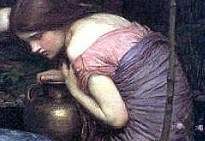

 John William Waterhouse
John William Waterhouse
Psyche Opening the Golden Box, 1903
Nymphs finding the Head of Orpheus,(detail) 1900
Psyche Opening the Door into Cupid's Garden, 1904
The Enchanted Garden (detail), 1916Page 80 of Anthony Hobson's 1978 dissertation, The Life and Work of J.W. Waterhouse, R.A., begins with the closing lines of a quotation from The Magazine of Art that accompanied a reproduction of Waterhouse's 1893 painting, La Belle Dame Sans Merci: "… the artistic and poetic mystery and tenderness of La Belle Dame Sans Merci were widely, though not fully, acknowledged, and the work was held to mark another step forward in the career of its accomplished author" (also Art, 76). In the next paragraph, Dr. Hobson wrote: "Waterhouse's newly-discovered model for this picture was his ideal type, and she appeared appropriately as A Mermaid … in his Diploma Work for the Royal Academy. ..." (also Art, 76). The page ends with these lines: "... the girl in question sat for him regularly. She can be identified in most of the major subject pictures of the following years. We are told that he treated her very well, and that she sent a beautiful wreath to his funeral" (also Art, 77). (Followed in Anthony Hobson's dissertation by the footnote: "Mrs. Donner, who owns a study for Psyche Opening the Golden Box …, in which this model appears, in conversation with the author.") 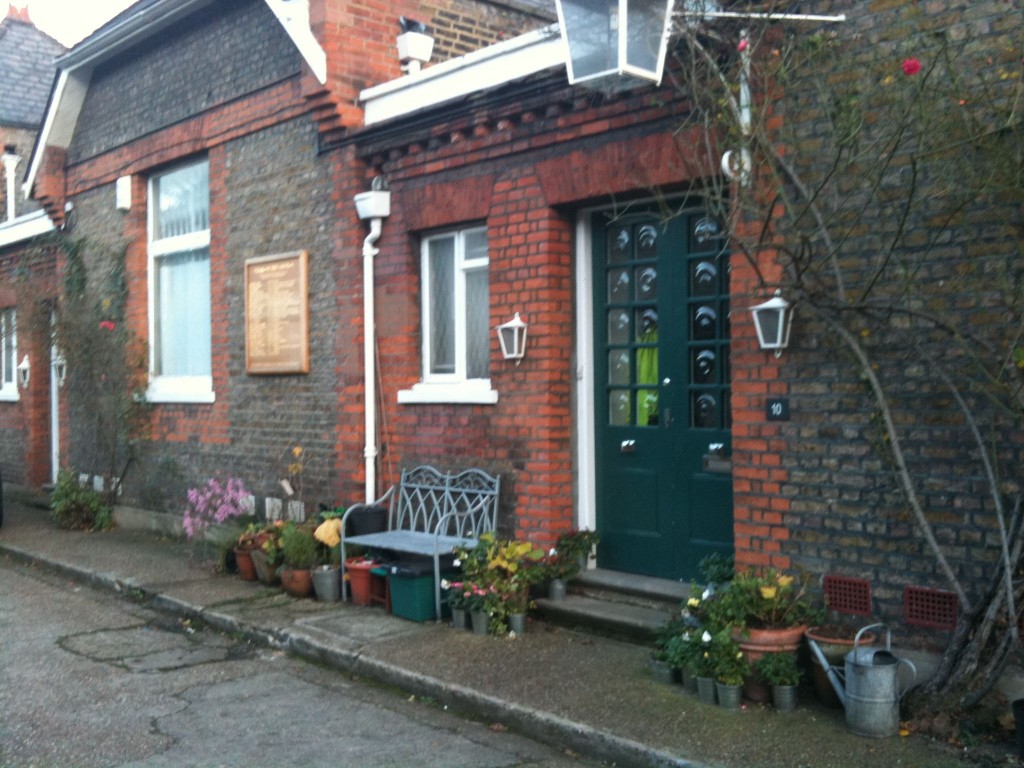
primose hill studiosDr. Hobson's 1980 Catalogue of Works includes listings for studies in oils, paintings, pencil studies and chalk studies that Gwendoline was given. enchanted garden by waterhouse showing muriel foster his fav model In the picture credits of Peter Trippi's book about the artist, The Merman (c. 1892), a Landscape sketch for A Naiad (1892), and a Study for Flora in Flora and the Zephyrs (c. 1897-8) are listed in the same private collection as a chalk study of Beatrice McKay Gunn, Gwendoline's sister (Trippi, 251). I didn't find listings for the second two works in Dr. Hobson's 1980 Catalogue of Works, but The Merman is among the Catalogue’s entries. Dr. Hobson begins the provenance of the painting with Esther Waterhouse, the painting being part of her late husband's estate. It was given by Esther to Gwendoline Gunn and Gwendoline bequeathed it to her daughter (Art, 195). Holiday times at the beautiful seaside retreat of Croyde most likely provided some of Waterhouse's inspirations for A Mermaid and other paintings ... and the gift of The Merman must have been a treasured reminder of those times along the Devon coast.
enchanted garden by waterhouse showing muriel foster his fav model In the picture credits of Peter Trippi's book about the artist, The Merman (c. 1892), a Landscape sketch for A Naiad (1892), and a Study for Flora in Flora and the Zephyrs (c. 1897-8) are listed in the same private collection as a chalk study of Beatrice McKay Gunn, Gwendoline's sister (Trippi, 251). I didn't find listings for the second two works in Dr. Hobson's 1980 Catalogue of Works, but The Merman is among the Catalogue’s entries. Dr. Hobson begins the provenance of the painting with Esther Waterhouse, the painting being part of her late husband's estate. It was given by Esther to Gwendoline Gunn and Gwendoline bequeathed it to her daughter (Art, 195). Holiday times at the beautiful seaside retreat of Croyde most likely provided some of Waterhouse's inspirations for A Mermaid and other paintings ... and the gift of The Merman must have been a treasured reminder of those times along the Devon coast. Another painting Dr. Hobson lists in his Catalogue of Works as being given to Gwendoline is a study for Psyche Opening the Golden Box (Art, 189). As mentioned above, Gwendoline's daughter owned the painting at the time she shared with Dr. Hobson information about the model he wrote sat for Waterhouse "regularly" ... the person thought to "be identified in most of the major subject pictures of the following years" ... including this one. In a conversation with Dr. Hobson about the model, Mrs. Donner shared that Waterhouse "treated her very well, and that she sent a beautiful wreath to his funeral." Why did Esther give the painting to Gwendoline? Was it a gift to a cherished friend who only sat "for paintings of herself" ... or in addition to being a cherished friend, could Gwendoline also have been the person her daughter referred to in the conversation with Dr. Hobson … the person who sat for Waterhouse regularly and "sent a beautiful wreath to his funeral"? With no records to confirm or deny this, we unfortunately can't know for sure. A member of her family doesn't believe the quotation refers to Gwendoline. As a friend who sat for the artist she must have been an inspiration to him, though, and is surely a part of that unique beauty represented in the art of J. W. Waterhouse. Gwendoline came into Nino and Esther's lives in the early 1890s when they began to join the Feeney's for holidays in the Croyde area. Peter Trippi has said this is the time period when Waterhouse "hits his mature style" and when the figures in his paintings "come into what we call the 'Waterhouse girl'." Dr. Hobson wrote about a "newly-discovered model" that Waterhouse was inspired by during this time period. Perhaps the girl they met at Croyde with the same Scottish heritage as his mother was both a friend through the coming years and a source of inspiration to his art as members of his family had been.
The faces of models and friends filled his sketchbooks and canvases over the years.
Anthony Hobson wrote:"Any consideration of his later work will show how closely his pictures are built around
the actual presence in the studio of a few favourite models …" (Art, 76; Life, 80).



“… both his sketches and paintings foster the idea of his quiet daily retreat into the basement
studio with the beautiful young model and a volume of Shelley or Tennyson for inspiration" (Art, 111).
"... there is a whole series of finely modeled female heads in chalk, a number of which may be of friends rather than professional models. Both are extremely difficult to identify after this lapse of time, even with the aid of the names and addresses scribbled into his sketchbooks." He continues, "But the paintings show how as the years went by he continually sought his ideal vision of womanhood, rather than some character type adapted to each new subject. The remarkable thing is that he found her and remained faithful to her in his art, reflecting the distant ideal of medieval courtly love in the warmed mirrors of Italian passion and Greek sensuality."
(Anthony Hobson, The Art and Life of J W Waterhouse RA 1849-1917, 1980)
Some photos from Flickr show a few of the pages from the sketchbooks that were on exhibit at the Groninger Museum when the Waterhouse exhibition was there. Two photographs of the sketchbooks from Peter van der Steege and another from Sandori.
Julia Kerr found the following statement written by Waterhouse. It comes from the March 1908 issue of The Strand Magazine. In the article, Artists and Beauty: The Opinions of Eminent Painters, the artists were asked to select from a group of photographs the person they would want as a model. Waterhouse wrote of his choice:
“If I had to select one of these ladies,” said Mr. Waterhouse, “as a model for painting, I should have no hesitation about my choice. The lady of my preference, indeed, reminds me very much of one of my models. After she had been sitting to me for some time she went on the stage, and succeeding in obtaining fairly important parts, she naturally did not care to resume her former profession, and for some time I have lost sight of her. She sat only for the face. The face, as in this photograph, is so singularly beautiful that I was very sorry to lose the opportunity of painting it, and I have written once or twice lately to the lady's old address but without obtaining a reply.”
The following is the photograph Waterhouse selected:
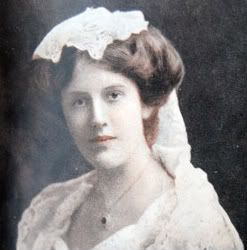
(Image courtesy Julia Kerr)
The above quotation is important as it is the first known quotation from the artist about his preference for a model and includes some information about a woman who was a model for him "for some time". Perhaps research will lead us to the identity of the person he wrote about.-
Some Names of Models We Now Know
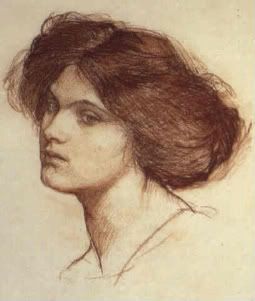 John William Waterhouse
John William Waterhouse
Head of a Girl
(Private Collection) Anthony Hobson believed the knight cloaked in armour in La Belle Dame Sans Merci was "emblematic of" Waterhouse's "own Victorian propriety," and he wrote, "there has been no suggestion of any dubious relationship between J W Waterhouse and his models". Karen E. Sullivan in her 1996 book, Pre-Raphaelites, describes Waterhouse as a quiet man with none of the "private passions" and turbulent home life that characterized many of the Pre-Raphaelites.
Rupert Mass wrote, it "is likely to be that he chose his models as subjects of his romantic vision, not that the models themselves were the object of it, and that is why his beautiful yearning girls conform to a type.”
The list of Waterhouse models has grown since only family members Jessie, Mary and Esther Waterhouse were known about. Some names are gladly now known, but not the detailed stories that go with the individuals that sat before Waterhouse as he sketched or painted. Most of the names are of models that also worked with other artists of the time. Hopefully more names and their stories will come to light in the future.
Waterhouse Models
Alice Arter
Ethel Bantock
Harry Beresford
Angelo Colarossi
'Miss Kate Double'
'Miss Muriel Foster'
Beatrice Hackman
'Miss Lloyd'
Agnes Richardson
Edith Richardson
-----------
-- Alice Arter --
A June 1896 journal entry by John Paul Cooper has revealed Alice Arter was a Waterhouse model. Peter Trippi shared, "... the Arts & Crafts designer, John Paul Cooper, wrote in 1896 that Alice Arter sat for Waterhouse ...". The information originally appeared in N. Natasha Kuzmanovic's 1999 publication, John Paul Cooper: Designer and Craftsman of the Arts & Crafts Movement and reads, "... have been working at Gesso workbox particularly the frieze of figures on the front for which I have had Alice Arter to sit to me. She sits to Burne-Jones, Sargeant [sic], Abbey and Waterhouse." (Example of a 1908 gesso box designed by John Paul Cooper.)
 Ethel Bantock Harry Beresford --
Ethel Bantock Harry Beresford --
 John William Waterhouse
John William Waterhouse
Echo and Narcissus, 1903
(Walker Art Gallery, Liverpool, England)Some of Waterhouse's sketchbooks are at the Victoria and Albert Museum in London as a gift from Dr. John Physick, the great-nephew of the artist. In his article, A Waterhouse Sketch Discovered, Scott Thomas Buckle writes about finding the names of four Waterhouse models written on the pages of one of the sketchbooks: Angelo Colarossi, Harry Beresford, 'Miss Bantick' and Kate Double.
He shares with us that, V&A sketchbook (E.1111-1963), "contains a preparatory sketch for Echo and Narcissus inscribed with the names and addresses of two models. The first, 'Beresford', of '19 St Olaf's Road, Fulham', can be found in the 1901 Census lists as 'Henry Beresford', a 21 year old whose profession is given as 'Artist's Model'. ... The second name beside the 'Echo and Narcissus' sketch in the V&A sketchbook (and seemingly unrecorded in any published literature on Waterhouse) is a 'Miss Bantick'." (Scott Thomas Buckle)
In Scott's most recent article, Ethel and Narcissus - a closer look at two of Waterhouse’s models, he shares about an address book that once belonged to Waterhouse's friend and fellow artist, John Seymour Lucas. This was an important source of information he used to confirm Ethel Bantock (first thought to be 'Bantick') was the model Waterhouse had made a note about on his sketch for Echo and Narcissus. Sketches of both Harry Beresford and Ethel Bantock are in the Seymour Lucas address book. (images shared in Scott's article)
Several months ago I was looking through some copies of the Royal Academy Pictures and Sculpture series and found a drawing by John Seymour Lucas in the 1907 edition titled, Mrs Massey-Beaumont. The person in the drawing reminded me of Seymour Lucas's sketch of Ethel Bantock from his address book. A Roundaley by Seymour Lucas serves as the frontispiece of the book and the woman in the painting seemed to resemble the woman in the drawing which made me wonder if she had been the model for the painting. When I checked through online marriage records I found that an 'Ethel Bantock' of Fulham, London married in 1903. Had Ethel's married name become 'Massey-Beaumont'?
After receiving a copy of the marriage certificate I found that Ethel had married the artist and engraver, Robert Stewart Clouston. So, it seems the sketch of Mrs Massey-Beaumont wasn't of Ethel. Ethel Bantock became Mrs R S Clouston on Thursday, November 26, 1903. The ceremony took place at the Fulham Register Office
So, it seems the sketch of Mrs Massey-Beaumont wasn't of Ethel. Ethel Bantock became Mrs R S Clouston on Thursday, November 26, 1903. The ceremony took place at the Fulham Register Office with two witnesses. Robert was 46 years old at the time of the wedding and a widower. Ethel was 28 years old. They both lived in the Shepherds Bush area of London. Clouston's address was given as 151 Percy Road and Ethel's as 111 Coningham Road - which as Scott pointed out is just east of Percy Road and north of Ravenscourt Park.
with two witnesses. Robert was 46 years old at the time of the wedding and a widower. Ethel was 28 years old. They both lived in the Shepherds Bush area of London. Clouston's address was given as 151 Percy Road and Ethel's as 111 Coningham Road - which as Scott pointed out is just east of Percy Road and north of Ravenscourt Park.  Scott also shared that Angelo Colarossi was a Percy Road resident, at number 93. Robert's father, Charles Clouston is listed as a 'Clergyman' on the certificate and James William Bantock, Ethel's father, a 'Chemist'.
Scott also shared that Angelo Colarossi was a Percy Road resident, at number 93. Robert's father, Charles Clouston is listed as a 'Clergyman' on the certificate and James William Bantock, Ethel's father, a 'Chemist'.
W S Hewison's Who was Who in Orkney gives this information about Clouston: "b.1857 Sandwick, Orkney d.1911 Sydney, Australia. Artist; s. of Rev Charles Clouston and Margaret Clouston of Smoogro, Orphir. Educ. St Andrews, Edinburgh University 1876 and studied art at Royal Scottish Academy College of Art, Edinburgh. Exhibited at both Royal Academy, London and Royal Scottish Academy, Edinburgh, mainly portraits and mezzotints, an art form in which he was recognised as a leading exponent in the country and for which he devised a new method of preparing the plates. Interested in archaeology he carried out first excavation of Onston cairn in Stenness. Also produced book on 18th century furniture ... Moving to New Zealand for health reasons continued painting, mostly portraits."
The Royal Academy of Arts: A Complete Dictionary of Contributors and Their Work from Its Foundation in 1769 to 1904 (1905) gives a list of the engravings shown by Robert at the Royal Academy beginning in 1888 until 1897. The sketch of Ethel in the Seymour Lucas address book is thought to have been made circa 1896-7.
It seems Robert and Ethel moved to the Mayfair area of London after they married. Both the 1904 and the 1905 The Year's Art give "29 Maddox st., W"  as the address of R. S. Clouston. This location is northeast of the Royal Academy and it had been the home of the woodcarver George Alfred Rogers until his death in 1897.
as the address of R. S. Clouston. This location is northeast of the Royal Academy and it had been the home of the woodcarver George Alfred Rogers until his death in 1897.
Basil Hunnisett wrote in his 1998 publication, Engraved on Steel: The History of Picture Production Using Steel Plates that "Clouston emigrated to Australia in 1909 and died there after an accident in 1911. ..." The following is from the book, Nineteenth Century New Zealand Artists: A Guide & Handbook: "CLOUSTON, Robert S. d.1911 ... Exhibited with NZ Academy of Fine Arts 1909–10."
So, it seems Ethel and Robert were married eight years when she became a widow in 1911. One would imagine she traveled to Australia with him - did she remain there after his death? Hopefully more information will be discovered about her life. (More information has been found recently to confirm they lived in New Zealand (and then Australia for a short time) ... I hope to update this soon.)
-- Angelo Colarossi --
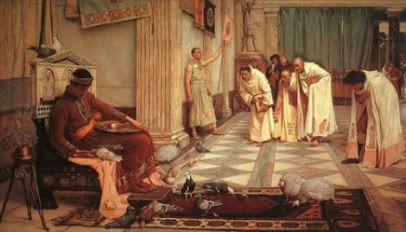 John William Waterhouse
John William Waterhouse
The Favourites of the Emperor Honorius, 1883
(Art Gallery of South Australia, Adelaide) In A Waterhouse Sketch Discovered, Scott Thomas Buckle reveals "that the name 'A Colarossi' is inscribed by the artist" in V&A sketchbook (E1109-1963), verifying an association between Waterhouse and the Italian model, Angelo Colarossi.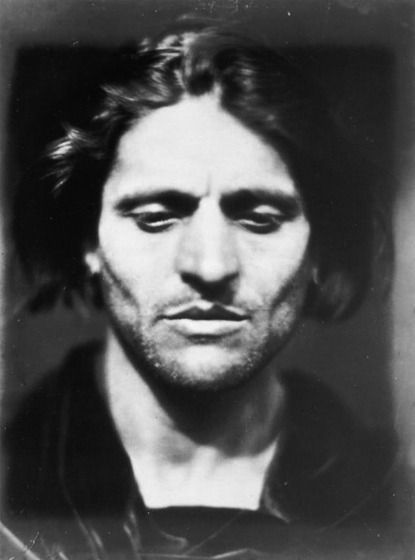 Scott goes on to share that Colarossi can be seen "in the background of the 1883 painting The Favourites of the Emperor Honorius ..." (See fourth image in Scott's
Scott goes on to share that Colarossi can be seen "in the background of the 1883 painting The Favourites of the Emperor Honorius ..." (See fourth image in Scott's "There has been much speculation into the identity of the models used by the artist John William Waterhouse.
"There has been much speculation into the identity of the models used by the artist John William Waterhouse.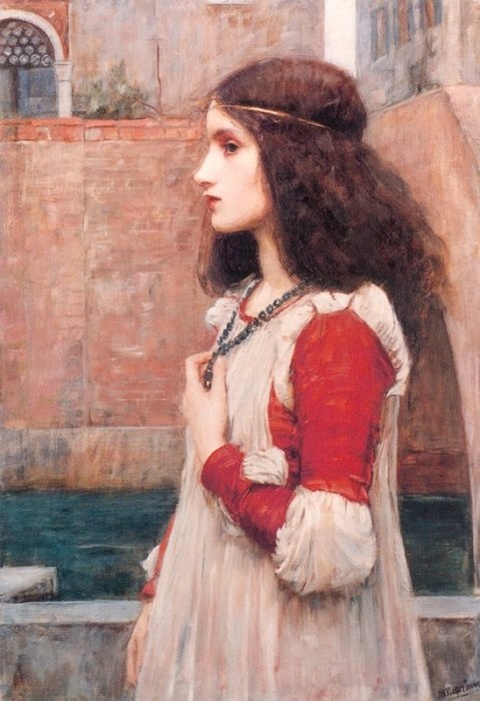 Whilst the focus up until now has been upon the female faces and figures that populate his pictures, a recently discovered sketch introduces the name of a well-known Victorian male model to Waterhouse's oeuvre. The drawing, an unattributed sketch
Whilst the focus up until now has been upon the female faces and figures that populate his pictures, a recently discovered sketch introduces the name of a well-known Victorian male model to Waterhouse's oeuvre. The drawing, an unattributed sketch  depicting the head of an old Hussite warrior (or so the label would have us believe) was found by an art dealer in Prague amongst a folio of loose prints and drawings by various artists. The handling of the drawing was close to Waterhouse's style,
depicting the head of an old Hussite warrior (or so the label would have us believe) was found by an art dealer in Prague amongst a folio of loose prints and drawings by various artists. The handling of the drawing was close to Waterhouse's style, even if the subject matter was not, and two inscriptions at the top and bottom of the sheet would prove to be vital clues in unravelling the mystery behind the hurried little drawing.
even if the subject matter was not, and two inscriptions at the top and bottom of the sheet would prove to be vital clues in unravelling the mystery behind the hurried little drawing. 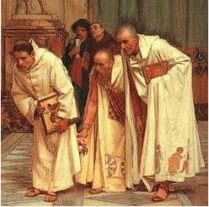 John William Waterhouse
John William Waterhouse
The Favourites of the Emperor Honorius (detail), 1883
(Art Gallery of South Australia, Adelaide)
-- 'Miss Kate Double' --
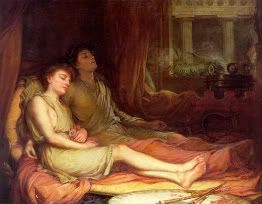 John William Waterhouse
John William Waterhouse
Sleep and His Half-Brother Death, 1874
(Private Collection) It is believed Waterhouse sketched the young men in Sleep and His Half-Brother Death "from a female model" (Trippi, 29). A note in Peter Trippi's book describes a drawing found in V&A sketchbook (E1109-1963): "a sleeping head is annotated 'Miss Kate Double ...'. It seems the sketch of 'Miss Kate Double' was one preparatory work done by Waterhouse for his painting from 1874. Scott Thomas Buckle shares in his article, A Waterhouse Sketch Discovered, that Kate Double "is known to have posed for Whistler."
Beatrice Hackman
Beatrice's grandson shared with Anthony Hobson and later with us and others that she had been a Waterhouse model. He said that she would visit his gravesite after the artist's death. In recent years a family member wrote about Beatrice as a model at this website's forum. The family believes she was a model for Waterhouse's The Soul of the Rose.
-- 'Miss Lloyd' --
 Sir Frank Dicksee
Sir Frank Dicksee
The Mirror, 1896
Private Collection Letter to Miss Lloyd, written by Julia Kerr, gives information about a letter written from Waterhouse to 'Miss Lloyd'. It is thought the letter is addressed to Mary Lloyd. Julia shared in the article that Lloyd was "a professional artists' model
Julia shared in the article that Lloyd was "a professional artists' model who sat for several well-known Victorian painters, including Sir Frank Dicksee and Lord Leighton". In the short note, Waterhouse asks 'Miss Lloyd' if she is available to sit for him and asks to meet with her at the Royal Academy.
who sat for several well-known Victorian painters, including Sir Frank Dicksee and Lord Leighton". In the short note, Waterhouse asks 'Miss Lloyd' if she is available to sit for him and asks to meet with her at the Royal Academy.
Dear Miss LloydCan you take a sittingfor the head at theR.A. on Tuesdaynext? If so will you be at the schools at a quarter before ten.Yours trulyJ. W. Waterhouse
pink marks the master














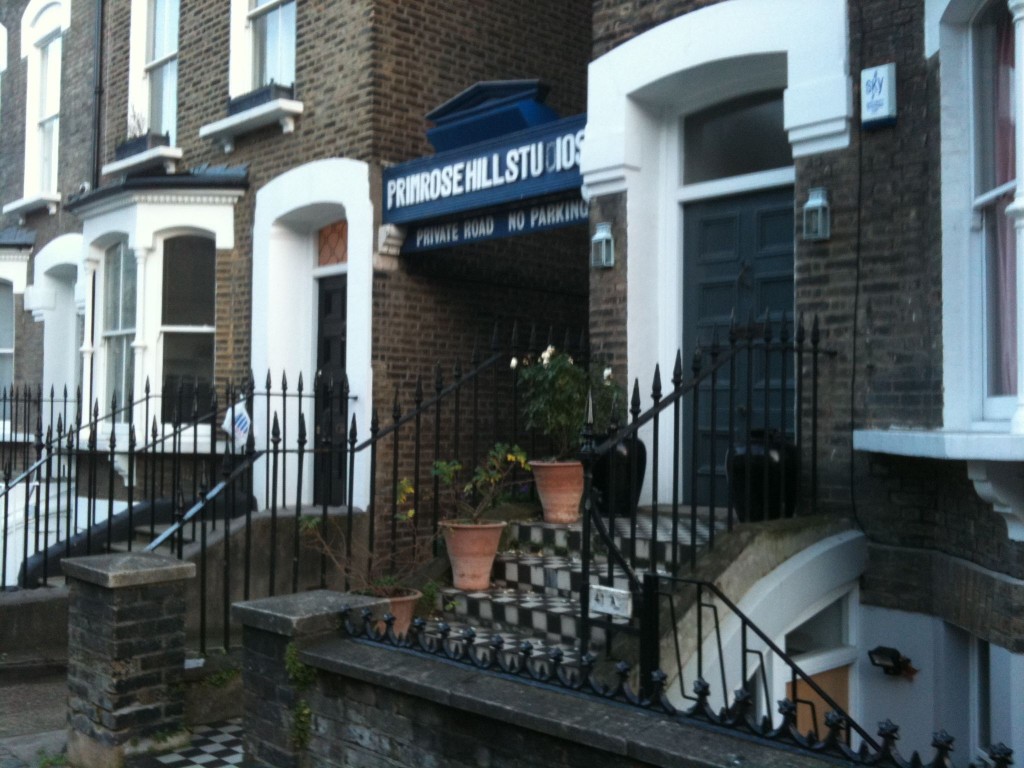

 whilst looking through John William Waterhouse’s old sketchbooks at the V&A, I discovered the names of several models,
whilst looking through John William Waterhouse’s old sketchbooks at the V&A, I discovered the names of several models, recorded by the artist along with details of their addresses. In one of the sketchbooks (E.1111-1963) two names particularly caught my attention as they were inscribed, as an aide-mémoire for the artist,
recorded by the artist along with details of their addresses. In one of the sketchbooks (E.1111-1963) two names particularly caught my attention as they were inscribed, as an aide-mémoire for the artist,  "Lachrymae," the title chosen by the artist, is the Latin word for "tears." Every aspect of the composition emphasizes the subject, from the fading sunset to the cypress trees (traditional symbols of death, because once cut, they do not regenerate) and laurel bushes (like cypress, laurel is evergreen and, thus, a symbol of immortality). The overall Hellenic theme of the canvas reflects contemporary Victorian interest in Greek funerary art.model mary lyold
"Lachrymae," the title chosen by the artist, is the Latin word for "tears." Every aspect of the composition emphasizes the subject, from the fading sunset to the cypress trees (traditional symbols of death, because once cut, they do not regenerate) and laurel bushes (like cypress, laurel is evergreen and, thus, a symbol of immortality). The overall Hellenic theme of the canvas reflects contemporary Victorian interest in Greek funerary art.model mary lyold matched up with an entry for a ‘Henry Beresford’ in the 1901 Census. The 21 year old was living there with his 42 year old widowed mother, Clara, and gives his occupation as ‘Artist’s Model’ in the census entry. Fulham may initially seem an unlikely place to find the model for Narcissus, but the area had been home to artists like Burne-Jones and Holman Hunt, and a number of Italian models had settled in the neighbouring borough of Hammersmith.
matched up with an entry for a ‘Henry Beresford’ in the 1901 Census. The 21 year old was living there with his 42 year old widowed mother, Clara, and gives his occupation as ‘Artist’s Model’ in the census entry. Fulham may initially seem an unlikely place to find the model for Narcissus, but the area had been home to artists like Burne-Jones and Holman Hunt, and a number of Italian models had settled in the neighbouring borough of Hammersmith.
 ,
, 
 had modelled for John William Waterhouse’s Echo and Narcissus, but also that, aged 14, he had posed for Draper’s the Youth of Ulysses, although in the finished version of that painting the artist worked from Giuseppi Servi, a young ice cream vendor from
had modelled for John William Waterhouse’s Echo and Narcissus, but also that, aged 14, he had posed for Draper’s the Youth of Ulysses, although in the finished version of that painting the artist worked from Giuseppi Servi, a young ice cream vendor from  Hammersmith. The final model for the head of ‘Athene’ in Draper’s painting was Mary Lloyd, who is also known to have posed for Waterhouse, amongst others. It is also known that Waterhouse introduced Draper to another of his models, Agnes Richardson, although Draper thought her sister Edith the better model.
Hammersmith. The final model for the head of ‘Athene’ in Draper’s painting was Mary Lloyd, who is also known to have posed for Waterhouse, amongst others. It is also known that Waterhouse introduced Draper to another of his models, Agnes Richardson, although Draper thought her sister Edith the better model.

 I had no trouble finding ‘Ethel Bantock’ in the 1901 Census – listed as a 25 year old artist’s model living in Hammersmith. Seymour Lucas records two addresses for Miss Bantock, the second at
I had no trouble finding ‘Ethel Bantock’ in the 1901 Census – listed as a 25 year old artist’s model living in Hammersmith. Seymour Lucas records two addresses for Miss Bantock, the second at Whilst Seymour Lucas was a very successful painter of history genre artworks, his pupil, Frederic Roe (1864-1947), proved to be a very competent follower of his style, and just as successful. It would appear, then, that the younger artist had spotted the Bantock and Beresford double-act first, and then introduced them to Seymour Lucas several years before they were to sit to Waterhouse in the roles of Echo and Narcissus. It has proved more difficult spotting Ethel Bantock amongst Seymour Lucas’s many canvases, although I had at least some success in finding her in one of Fred Roe’s paintings. Throughout the 1890s he often treated the subject of Joan of Arc, but it is his 1906 Royal Academy picture Martyrdom: Joan of Arc on her way to Execution that most obviously features the elusive Ethel. For the figure of St Joan, the artist has chosen a model with a strong jaw, fair skin and a left foot that looks identical to Echo’s. She appears again in a Study for Joan the Martyr painted by Roe in 1905.
Whilst Seymour Lucas was a very successful painter of history genre artworks, his pupil, Frederic Roe (1864-1947), proved to be a very competent follower of his style, and just as successful. It would appear, then, that the younger artist had spotted the Bantock and Beresford double-act first, and then introduced them to Seymour Lucas several years before they were to sit to Waterhouse in the roles of Echo and Narcissus. It has proved more difficult spotting Ethel Bantock amongst Seymour Lucas’s many canvases, although I had at least some success in finding her in one of Fred Roe’s paintings. Throughout the 1890s he often treated the subject of Joan of Arc, but it is his 1906 Royal Academy picture Martyrdom: Joan of Arc on her way to Execution that most obviously features the elusive Ethel. For the figure of St Joan, the artist has chosen a model with a strong jaw, fair skin and a left foot that looks identical to Echo’s. She appears again in a Study for Joan the Martyr painted by Roe in 1905.

 He was then thirty-four and she twenty-five. The names of his father, his step-mother, his sister Jessie, the bride’s mother and one of her brothers appear on the marriage certificate. Esther’s father, James Lees Kenworthy – himself an artist, who with his wife kept a school in Ealing – had died seven years previously.” (Anthony Hobson, The Art and Life of J.W. Waterhouse, RA, 1849-1917, 1980)
He was then thirty-four and she twenty-five. The names of his father, his step-mother, his sister Jessie, the bride’s mother and one of her brothers appear on the marriage certificate. Esther’s father, James Lees Kenworthy – himself an artist, who with his wife kept a school in Ealing – had died seven years previously.” (Anthony Hobson, The Art and Life of J.W. Waterhouse, RA, 1849-1917, 1980)
 Another record of her work is found in The Royal Academy of Arts: A Complete Dictionary of Contributors and Their Work from Its Foundation in 1769 to 1904 by Algernon Graves - she is listed in Vol. IV as Miss Esther Kenworthy and then in Vol. VIII as Mrs. John William Waterhouse. Her husband's name appears just before hers in Vol. VIII with the list of paintings he exhibited at the Royal Academy through 1904.
Another record of her work is found in The Royal Academy of Arts: A Complete Dictionary of Contributors and Their Work from Its Foundation in 1769 to 1904 by Algernon Graves - she is listed in Vol. IV as Miss Esther Kenworthy and then in Vol. VIII as Mrs. John William Waterhouse. Her husband's name appears just before hers in Vol. VIII with the list of paintings he exhibited at the Royal Academy through 1904.
 Alma-Tadema and Hacker. Waterlow shared the Waterhouses' studios in 1892-3 during the renovation of his house, an experience commemorated by an unattributed caricature inscribed 'January 1893, Primrose Hill School'.
Alma-Tadema and Hacker. Waterlow shared the Waterhouses' studios in 1892-3 during the renovation of his house, an experience commemorated by an unattributed caricature inscribed 'January 1893, Primrose Hill School'. In 1901 he is back in Croyde himself although the address is given as Baggy Point. The Census was recorded in order geographically and as this address appears in the same place in both years in relation to others I would think that the name of the property was either omitted or had been changed at this time
In 1901 he is back in Croyde himself although the address is given as Baggy Point. The Census was recorded in order geographically and as this address appears in the same place in both years in relation to others I would think that the name of the property was either omitted or had been changed at this time and there is a property known as 'Baggy House' ... If my memory serves me well the original house was demolished and replaced by a new building [2nd photo] of award winning design in recent years ... Looking at large scale OS mapping 'Baggy House' does not appear on the 1st Edition 25" c.1889 but does on the 2nd Edition c.1904. However there are other unnamed properties, one of which is further along the point and near a spring to which the name could have applied but this doesn't appear to be on the modern map."
and there is a property known as 'Baggy House' ... If my memory serves me well the original house was demolished and replaced by a new building [2nd photo] of award winning design in recent years ... Looking at large scale OS mapping 'Baggy House' does not appear on the 1st Edition 25" c.1889 but does on the 2nd Edition c.1904. However there are other unnamed properties, one of which is further along the point and near a spring to which the name could have applied but this doesn't appear to be on the modern map." 





 enchanted garden by waterhouse showing muriel foster his fav model
enchanted garden by waterhouse showing muriel foster his fav model



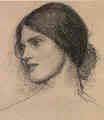


 John William Waterhouse
John William Waterhouse Ethel Bantock Harry Beresford --
Ethel Bantock Harry Beresford -- John William Waterhouse
John William Waterhouse So, it seems the sketch of Mrs Massey-Beaumont wasn't of Ethel. Ethel Bantock became Mrs R S Clouston on Thursday, November 26, 1903. The ceremony took place at the Fulham Register Office
So, it seems the sketch of Mrs Massey-Beaumont wasn't of Ethel. Ethel Bantock became Mrs R S Clouston on Thursday, November 26, 1903. The ceremony took place at the Fulham Register Office with two witnesses. Robert was 46 years old at the time of the wedding and a widower. Ethel was 28 years old. They both lived in the Shepherds Bush area of London. Clouston's address was given as 151 Percy Road and Ethel's as 111 Coningham Road - which as Scott pointed out is just east of Percy Road and north of Ravenscourt Park.
with two witnesses. Robert was 46 years old at the time of the wedding and a widower. Ethel was 28 years old. They both lived in the Shepherds Bush area of London. Clouston's address was given as 151 Percy Road and Ethel's as 111 Coningham Road - which as Scott pointed out is just east of Percy Road and north of Ravenscourt Park. Scott also shared that Angelo Colarossi was a Percy Road resident, at number 93. Robert's father, Charles Clouston is listed as a 'Clergyman' on the certificate and James William Bantock, Ethel's father, a 'Chemist'
Scott also shared that Angelo Colarossi was a Percy Road resident, at number 93. Robert's father, Charles Clouston is listed as a 'Clergyman' on the certificate and James William Bantock, Ethel's father, a 'Chemist'



 John William Waterhouse
John William Waterhouse Scott goes on to share that Colarossi can be seen "in the background of the 1883 painting The Favourites of the Emperor Honorius ..." (See fourth image in Scott's
Scott goes on to share that Colarossi can be seen "in the background of the 1883 painting The Favourites of the Emperor Honorius ..." (See fourth image in Scott's "There has been much speculation into the identity of the models used by the artist John William Waterhouse.
"There has been much speculation into the identity of the models used by the artist John William Waterhouse. Whilst the focus up until now has been upon the female faces and figures that populate his pictures, a recently discovered sketch introduces the name of a well-known Victorian male model to Waterhouse's oeuvre. The drawing, an unattributed sketch
Whilst the focus up until now has been upon the female faces and figures that populate his pictures, a recently discovered sketch introduces the name of a well-known Victorian male model to Waterhouse's oeuvre. The drawing, an unattributed sketch depicting the head of an old Hussite warrior (or so the label would have us believe) was found by an art dealer in Prague amongst a folio of loose prints and drawings by various artists. The handling of the drawing was close to Waterhouse's style,
depicting the head of an old Hussite warrior (or so the label would have us believe) was found by an art dealer in Prague amongst a folio of loose prints and drawings by various artists. The handling of the drawing was close to Waterhouse's style, even if the subject matter was not, and two inscriptions at the top and bottom of the sheet would prove to be vital clues in unravelling the mystery behind the hurried little drawing.
even if the subject matter was not, and two inscriptions at the top and bottom of the sheet would prove to be vital clues in unravelling the mystery behind the hurried little drawing.


 Sir Frank Dicksee
Sir Frank Dicksee Julia shared in the article that Lloyd was "a professional artists' model
Julia shared in the article that Lloyd was "a professional artists' model who sat for several well-known Victorian painters, including Sir Frank Dicksee and Lord Leighton". In the short note, Waterhouse asks 'Miss Lloyd' if she is available to sit for him and asks to meet with her at the Royal Academy.
who sat for several well-known Victorian painters, including Sir Frank Dicksee and Lord Leighton". In the short note, Waterhouse asks 'Miss Lloyd' if she is available to sit for him and asks to meet with her at the Royal Academy. pink marks the master
pink marks the master